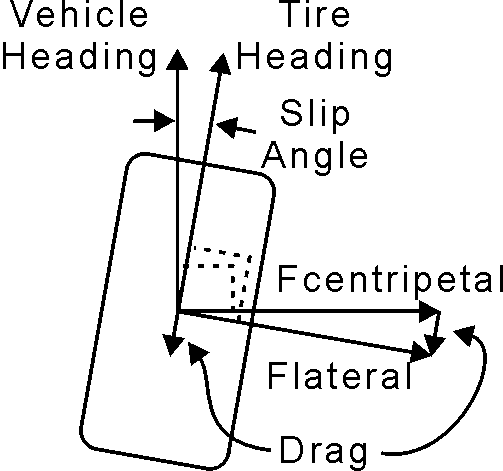INSIDE
RACING
T E C H N O L O G Y
IRT Home
IRT Home
News Page
Contents Page
Newsletter &
Books
email Paul
Tire Book Errata
I regret these errors but I'm also pleased there weren't more of them.
Page 107


In the original figure I made the mistake of drawing the drag vector opposite in direction to the tire heading. It should be in the opposite direction to the vehicle heading, it's a drag on the car. The explanation is correct but I should have included the point that Fcentripetal can't be bigger than the Flateral as it is in the original drawing. The tire can't generate a force on the car larger than its own lateral force.
The man who pointed out this error is Dr. Allen E. Fuhs, a Distinguished Professor Emeritus and SAE Fellow.
I thank Dr. Fuhs for caring enough about the subject to read the material carefully and to point out the error.
Page 215
"Percent anti-dive" should be Percent anti-squat.
Page 230
At the bottom of the page. In both these expressions I left out the notation that includes dividing by the track. The calculations on the next page using these expressions are correct.
"The rear roll force weight transfer fraction is A x
(CG - RC) x (RM/TM) / front track."
"The front roll force weight transfer fraction is A x (CG
- RC) x (FM/TM) / rear track."
Page 232
Under the Roll Angle heading, the first sentence reads: "The roll angle of the car depends on the roll moment and the roll resistance of the springs, anti-roll bars, and dampers." I should not have included dampers in this sentence.
The roll moment causes chassis roll until the roll resistance of the springs and anti-roll bars builds up to equal the role moment. When roll resistance equals the roll moment, roll stops. Dampers add roll resistance only when there is some movement of the shaft/piston in the damper. Just before roll begins there is no damper force because the damper shaft/piston is not moving. When roll stops there is no damper force for the same reason. So it's springs and bars alone that determine roll angle. Damper forces influence the time it takes for spring and bar forces to build up and they also influence tire contact-patch forces during roll, but they do not influence final contact-patch forces.
Page 238
Under the Caster heading I got mixed up on one sentence but the rest of the explanation is correct. The third sentence in the first paragraph should read:
"If caster is symmetrical, the same on both wheels, steering to the left lowers the left wheel vs. the chassis and raises the right.
Page 259
Under the Roll Resistance Distribution heading, first sentence in the third paragraph: ABR should be ARB. This is, of course, an abbreviation for Anti-Roll Bar.
I'll add more errata as I become aware of them.